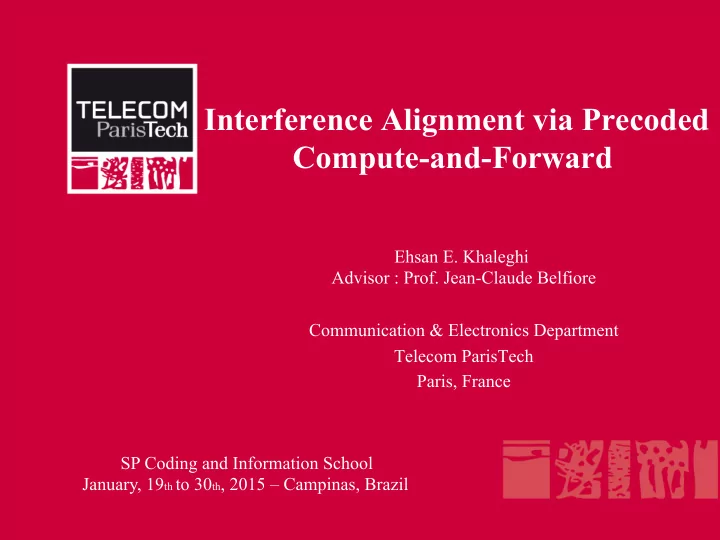

Interference Alignment via Precoded Compute-and-Forward Ehsan E. Khaleghi Advisor : Prof. Jean-Claude Belfiore Communication & Electronics Department Telecom ParisTech Paris, France SP Coding and Information School January, 19 th to 30 th , 2015 – Campinas, Brazil
Problematic Interference is one of the challenges in wireless communication systems. Ø Interference alignment (IA) is an interference management technique for increasing the channel capacity. Ø IA can be done via Compute-and-Forward (CoF) protocol. Ø We are interested to improve the fractal behavior of the achievable sum-rate defined for CoF protocol by Ø [Nazer et al. 2012] and [Ordentlich et al. 2012] for high values of signal-to-noise ratio (SNR). Fig. Upper Bound and achievable sum-rate versus g for 2-User GS-IFC [Ordentlich et al. 2012] . page 2 January 2015 Interference Alignement via Compute-and-Forward
Channel model & Lattice structure v Lattice Structure v Channel Model q In this work we consider the Nested lattice framework q The channel model is: The k -user GS-IFC. [Ordentlich et al. 2012]. q By using a simple lattice IA [Ordentlich et al. 2012] the K-user GS-IFC case is approximately equiv alent n to the 2-user case. q A lattice is a discrete additive subgroup of , i.e., Λ ℜ t , t where t t and t , t ∀ ∈ Λ + ∈ Λ − − ∈ Λ . 1 2 1 2 1 2 { } n M.Z : Z Λ = Α = ∈ Ζ n × n ¢ M: Generator matrix of a lattice ( ). v A Lattice is full-rank when its Gram matrix Is full-rank . Fig. 2-User GS-IFC. Ø All users have the same power constraint: 1 n 2 For n channel uses : x P with P P . ∑ ≤ = i i i n j 0 = 3 January 2015 Interference Alignement via Compute-and-Forward
Compute-and-Forward Transform with n Time-Slots ü No need of Channel Side Information (CSI) at transmitters. Ø When : SNR → ∞ v The worst choices of ‘g’ are rational numbers. v The best choices for ‘g’ are numbers equivalent to Golden ratio. When SNR is infinity, to avoid and reduce deep fadings in interested regimes: v decided to send codewords by using n different Time-slots. q Our idea is to precode at time-slot i the transmitted codewords by multiplying them, at the transmitters, by a real η number . i v By using this strategy, only one time-slot over n will result in a small sum-rate, for all values of ‘g’ . η v The best Choices for is Golden ratio or its equivalent numbers (slightly greater than 1). j 4 January 2015 Interference Alignement via Compute-and-Forward
Compute-and-Forward Transform with n Time-Slots ¢ The performance of our proposed scheme is shown below for 7 and 13 time slots. Fig. Upper Bound and achievable sum rate versus g for a 2-User GS-IFC with using our Fig. Upper Bound and achievable sum rate proposed scheme (Ts=7). versus g for a 2-User GS-IFC with using our proposed scheme (Ts=13). 5 January 2015 Interference Alignement via Compute-and-Forward
Thank you for your attention ... !! q E. Ebrahimi Khaleghi, J-C. Belfiore, “ Compute-and-Forward for the Interference Channel: Diversity Precoding ”, In Proceedings of the 2nd international Iran Workshop on Communication and Information Theory (IWCIT), Iran, Tehran, May 2014. 6 January 2015 Interference Alignement via Compute-and-Forward
Recommend
More recommend